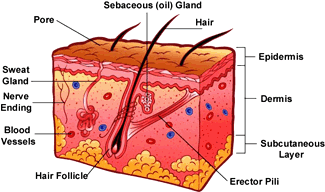What is the Comedogenic Scale and why does it matter?
What is Comedogenisis?
Comedogenesis is the measurement of the likelihood that an oil will clog your skin’s pores. Typically, the face is the most common area concerned by comedogenicity. A ‘comedo’ explained simply is a pimple or a blackhead. It is the body’s inflammatory response to a bacterial build up underneath the outermost protective layer of your skin - the stratum corneum.

Comedogenesis is a way of discerning which products will clog the pores (and cause breakouts) and which will travel well without disruption, and potentially aid the health of our skin.
The Comedogenic Scale is a useful tool when trying to discover a possible cause of acne, especially for those who regularly use skincare products. Additionally, it is a way of determining which products may be helpful in preventing or reducing acne by identifying the products that will clean, clear, and rehydrate the epidermis (skin).
Conditions such as human skin types, the environment in which we live, and the foods & products we consume all play major factors in the individual's response to an oil. For this reason, the comedogenic scale can only be used as a guide rather than a definitive rule that works for everyone.
For example: a person with oily skin may react with clogging (breakouts) from an oil with a score of 3 on the scale, whereas someone with dry skin could really use an oil that includes extra fatty acids needed for rehydration of the stratum corneum.
Some of the key factors to consider when looking at a product label to find it’s comedogenicity include:
- Dilution: An oil which is scored at 5 (highest) on the scale could be diluted with another oil to reduce the likelihood of clogging.
- Concentration: Similar to dilution, the concentration refers to what % of a product is made up of that ingredient. Labels will usually list the ingredients by weight in descending order.
This article includes a comedogenic scale list, which is helpful for investigating each ingredient in the products that you’re looking to use.
What causes a clog?
A clog (followed by an immune response) is caused by a build-up of bacteria on the skin. Typically, there are two main factors that result in this build-up - dry skin and oily skin. The health of our skin is largely dependent on having a balance of bacteria, hormonal releases, and environmental influences.
- When skin is dry and begins to crack, the elasticity decreases and the skin tightens. This causes the dead cells which normally flake off to remain on the skin’s surface and creates small cavities which bacteria from the outside environment can call home.
- Skin which has an above-normal level of sebum (your skin’s natural oil) creates a comfortable place for bacteria, allowing them to number up more easily than if there was a reduction in sebum.
- Naturally, we carry a biome (living culture) of bacteria over our skin. This is necessary for our health. Cleaning is needed to reduce build up of foreign bacteria, whilst cleaning too often can create an environment where the biome is unable to ward off unwelcome guests and perform protection services at full strength.
- Our skin is able to repair itself when it is well hydrated. Healthy skin maintains a balanced level of sebum and brings a flow of nutrients, as well as restoring elasticity. This eliminates dead skin cells when they are due, and reinvigorates the stratum corneum with a newer, younger, protective layer.
- Source

So what determines whether or not an oil will clog the skin?
The most dominant factor that influences whether an oil has a high or low Comedogenic score is the levels of fatty acids. Alpha Linoleic acid (Omega-3) and Linoleic acid (Omega-6) are considered essential fatty acids as they are not produced by the human body; unlike Oleic acid, which we produce naturally.
Oleic acid (Omega-9) is still beneficial to be added to our skin. Omega 9 is responsible for hydration as well as reducing sensitivity. Benefits of Omega-3 are its ability to restore the health of our skin barrier, whilst Omega-6 is a great ally in reducing inflammation.
Downing (et al) provide a comprehensive study investigating fatty acids and the causes of acne (check out the link to find out more).
A number of other fatty acids play a role in skin health and are found in skincare products. One of particular significance is Eicosenoic acid. This compound is an Omega-9 fatty acid which is found in particularly high proportions in jojoba oil - a popular oil for use on the skin due to its absorption properties and gentle benefits for multiple purposes.
For a more extensive list of the oils related to healthy skin, click here.
Is beard acne a common issue or do I have an anomaly?

Beard acne is certainly not abnormal, and in fact is solved just about as easily as it is caused! Throughout daily life, our beards can collect dust and dirt from a wide range of sources; depending on how wild your day is. If food alone was the culprit, we’re probably all guilty of letting some grease drop below the lip.
This build up of bacteria is a common reason why beard acne occurs. Coupled with the possibility of dry skin beneath your mane, it is likely that we all can groom more to protect the pores. Hydration of the skin on your chin and cleaning out bacteria in the beard is important when it comes to keeping your facial hair healthy and hygienic.
That’s why we created The Ultimate Beard Oil - to condition, heal and protect your beard whilst keeping it smelling fantastic! And of course, it’s non-comedogenic… Check it out here.
Our skin oil is also made from a delicate blend of non-comedogenic oils, designed to hydrate, heal and nourish your skin. Regardless of whether you have dry, normal or oily skin, this one is a winner!
About the Author

Dominic McBride is a free-spirited nomad, with a passion for adventure and improving the environment. When he isn’t travelling the world, you can find him creating insightful content, playing the djembe or relaxing in his hammock.
